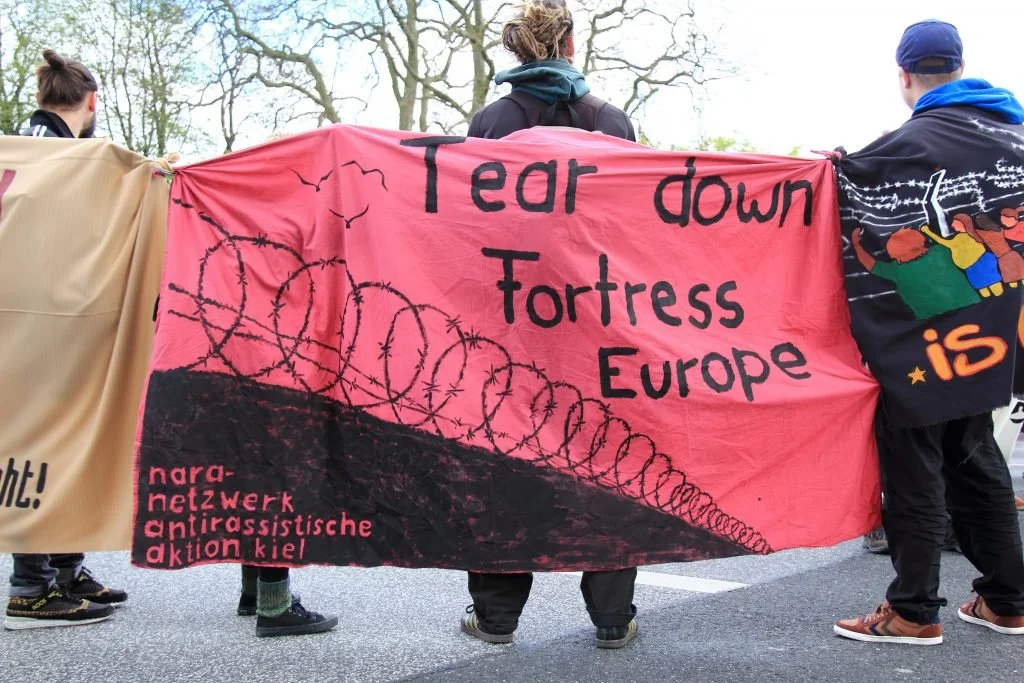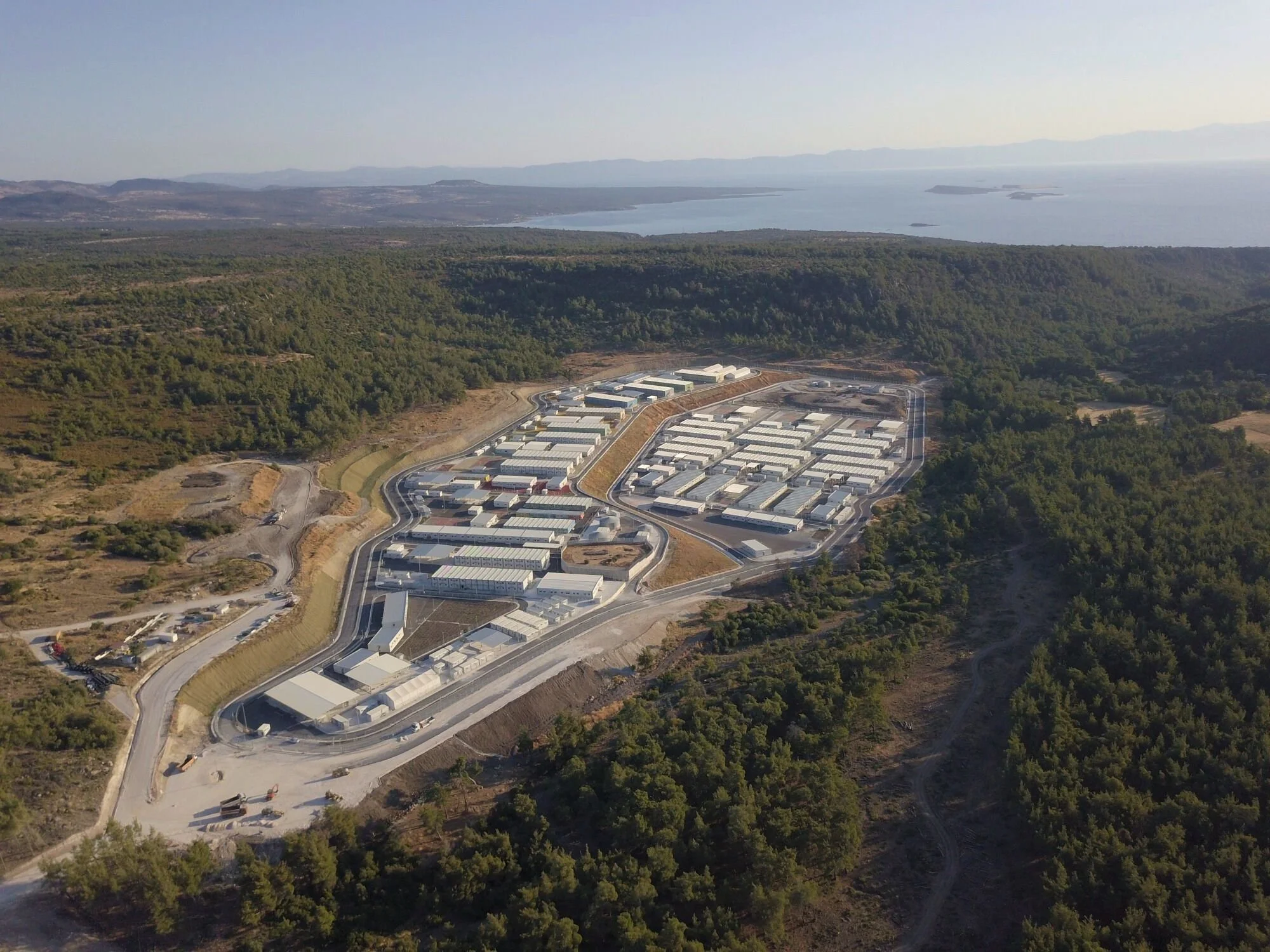Europe’s Values and Migration Hypocrisy: Inclusion for Some, Exclusion for Others
Photo by Rasande Tyskar, for an opinion piece about the “Fortress of Europe” on Society and Space
For inclusion to exist, there must also be exclusion to create difference and establish parameters for what is accepted and what is not. The migration narrative in Europe is increasingly establishing an inclusion agenda, and therefore an exclusive one, for who is allowed into Europe based on values associated with being “European”.
In 2023, a summit was held at the European Council of the European Union (EU), a governing body that guides the political direction of the EU, to discuss relevant political issues. At this summit migration was described as “a European challenge that requires a European response” and the EU should have a comprehensive response to migration “in line with EU principles and values and fundamental rights”.
EU Member States also recently agreed upon and began the implementation of the EU Pact on Migration, which seeks to further regulate, harmonise and coordinate Member States’ management of irregular arrivals. The basis of the pact is to harmonize policy responses and share the collective burden of migration. The pact is set to be introduced in June 2026 and entrench the enforcement of Migration as a European Problem. The pact however does little to benefit people on the move, and rather increases control on migration, reduces people’s rights, and lessens the possibility of entry by emphasizing detention and deportation.
This framing of migration is prevalent in policy and media, border actions, and in the lived experiences of people on the move. Making exclusion become a moral necessity to protect European values and culture allows inhumane and illegal policy to operate and mass border violence to occur.
Europeanness and Responsibility
The EU promotes six core foundational values: human dignity, freedom, democracy, equality, rule of law, and human rights. The EU also grounds its policy and values in principles such as rule of law, transparency, and accountability, and promotes having a cohesive response to migration. In opposition to these standardized values, we see the EU implementing securitization and externalization practices and policies in relation to migration, increased border violence, insurgence of anti-migration political parties across Europe, and constant anti-migration discourse in mainstream media.
Rampant border violence is prevalent in Greece where the coastguard has been accused of countless human rights abuses and acts of violence, including pushing back boats, forcing people who landed on Greek soil back to Turkish waters, physical beatings, and even instances of having their hands tied and then being thrown in the sea. These acts are being carried out by the coastguard, with the help of the police and army, and undercover individuals who are not in uniform. These acts are all illegal, and yet despite witness testimony, footage, and years of the same behavior, there is little to no accountability by the EU.
Highly armed members of security forces at the Greek border. Image by Human Rights Watch
Greece blatantly abusing and illegally sending back people is not an isolated issue; 122 EU officials, alongside their Libyan partners, have been accused of crimes against humanity due to their policies causing the deaths of tens of thousands of people in the Mediterranean and abuse against some 150 000 people. The EU is aware of the violent impact of their exclusionary policy, but avoids responsibility.
To avoid having to exercise these so-called European values when it comes to the treatment of migration, the EU categorizes migration as an ambiguous issue, allowing policy to operate in a state of exception or emergency where the normal rules do not apply. Terminology used in the media like ‘crisis’, or ‘an influx/flood/wave of migrants’, and ‘struggling to handle’, embeds this narrative of emergency which allows migration policy to operate differently. The European Migration Pact is no exception to these practices, because the Council is responsible for authorizing the application when exceptional circumstances or crises are present. No numerical or policy related bounds exist to determine an emergency or crisis situation, and therefore the new measures in place are relatively arbitrary and can be altered in most circumstances to fit what outcome is wanted. This idea of protecting Europeanness and values is more than a way to avoid responsibility, it is embedded in the border system.
Control and Detention
Frontex, the main border controlling party of the EU, directly claims its mission is to care for European citizens and protect European values. A major role of Frontex is externalizing EU borders to control migration from a distance and deter entry. The EU funds Frontex to keep people on the move in non-EU countries, like Serbia, to keep ‘unwanted’ people out and simultaneously avoid responsibility for violence. Migration as a European Problem assumes the practice of protecting a shared external border for the better of Europe and not just the benefit of an individual nation. The culture and discourse around Europeanization of borders creates an enabling environment for European countries to implement exclusionary policy which is left unquestioned, because the focus is on inclusion and the protection of high quality, liberal European values rather than on exclusion. This focus also categorizes violence as one-offs to certain circumstances or national policies that allows the idea of Europe as an imagined upholder of human rights and democracy to evade responsibility for facilitating a culture of exclusion.
Earlier this year, Greece suspended the ability, and right, of people arriving on boats from North Africa to claim asylum for 3 months and sent them back to their country of origin. This act put people in immediate danger and denied them their rights under EU and international law, yet was allowed to happen. Despite condemnation on this move from leading human rights institutions and the illegality of the suspension, the EU did nothing to bring accountability and showcases the wearing down of EU law when it comes to border practices.
For the people that have arrived in Greece, their treatment is no better. The Vastria Closed Controlled Access Centre (CCAC) is being constructed on Lesvos and demonstrates the increased control associated with bordering tactics.The CCAC will be a pre-removal detention centre that can hold up to 5000 individuals and institutionalizes long-term detention as the norm, and works very much in line with the new EU Migration Pact, as the border is no longer a point of entry and rather a marker for exclusion and containment. The detention centre is EU funded and being built despite mass local opposition to the social impact, environmental concerns, and legal grey areas of its construction and operation.
Overview of the CCAC. Image by CPT Aegean Migrant Solidarity
Racism
The discourse of Europeanness enables exclusion by normalizing moral and physical differentiations between European and non-European and is deeply rooted in race. Europeanness is associated with being socially and culturally ‘civilized’, a comparison always made against the country of origin, which is always understood as poor, underdeveloped, and uncivilized. In creating this difference in morality and values, European countries are able to justify exclusion without explicitly mentioning race. The construction of moral European values equating to civil and democratic values is a direct juxtaposition to the systematically produced exclusion of racialized people at and beyond the border that facilitates violence.
The most obvious example of the embedded racism in the EU migration agenda is the treatment of Ukrainian refugees versus those from the Middle East or African countries. Over 4 million Ukrainian refugees were welcomed into Europe with open arms, the system modified and changed rapidly to handle the influx of refugees. This change to the system was completely denied and seen as unattainable (and unwanted) during the height of the increased flow of people to European borders in 2015, when some 1 million people arrived. Ukrainian refugees were almost instantly given residence, the right to work, and access to education without even needing to seek asylum. EU countries who have historically outspoken anti-immigration sentiment suddenly had no issues welcoming Ukanian refugees who were deemed trusted, skilled and similar in values. This is not to say that Ukrainians do not deserve protection, but the difference in treatment is stark and reveals systemic bias. The difference in treatment is not only an act of Islamophobia, but sends a message to other people that they are less deserving of aid and acceptance on the basis of their being – not white and not European.
Freedom of movement is one of the biggest juxtapositions in the European migration narrative. Europe prides itself on the freedom for all EU citizens to move anywhere within the EU, however this freedom only exists at the expense and exclusion of others. Freedom in Europe is politically significant and promoted, but it is not accessible and safe for all. Those who do not have the freedom to move are those deemed not European, those who are constantly portrayed as a threat, the foreign Others. Ukrainian refugees were afforded easy movement within the EU, whereas under the EU Migration Pact, even if someone is granted asylum in an EU member state, they are not allowed to move to another.
Beyond the Border
The European focus is problematic because it fails to clearly define what it means to be European, and instead relies on juxtaposing assumed cultural and political superiority inherent to Europeanness against others. This vague, value based admissibility criteria can be exercised at the physical border in denying entry or pushing back boats, but also in constructing a normalized discourse and perceived idea of European versus non-European, a heavily racialized construction that institutionalizes exclusion.
The idea of handling migration in a harmonious way is also a farce – the majority of migration policy is still determined by individual nation states. It is simply a tactic to be exclusive and avoid responsibility for gross human rights violations and border violence. With the EU Migration Pact, the name is deceiving as it only covers so-called ‘irregular migrants’ who are seeking asylum. How people are treated past the asylum procedure or larger migration related topics like labour shortages and aging populations are still dealt with by the individual countries.
Creating an environment concerned with preserving European values, the narrative is more about protection and the promotion of something good, rather than the focus being on what is excluded. By claiming people on the move are opposite to Europeans or out of the ordinary, they are automatically seen as different and outsiders to justify denying them equal treatment. Values like human dignity and freedom are no longer applicable; border violence becomes acceptable, and rights that would be afforded to Europeans do not have to apply.
Designed to Fail
The system ultimately intends to deny people on the move a right to entry into Europe. The new EU Migration Pact and EU funded projects like CCAC showcase that at every turn the system chooses to exclude people through an emphasis on detention, violence, and humiliation. This exclusion is an intentional, racially motivated move made evident with the positive treatment of white, Ukrainian refugees. The guise of protecting European values and a shared European identity is an attempt for the EU to avoid accountability and responsibility to their own moral code. Values like human rights, human dignity, and freedom are forgotten when it comes to the EU’s relationship to migration. The system needs to change and the EU needs to be held accountable for their blatant hypocrisy.
Words by Rachel Hierholzer, Remote Research Officer



